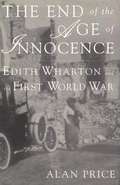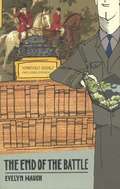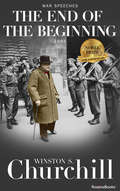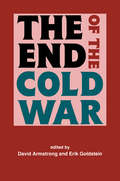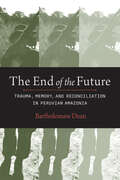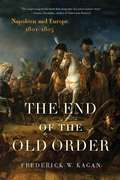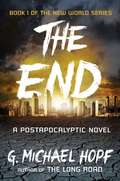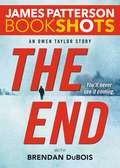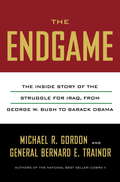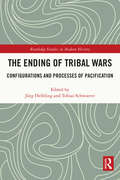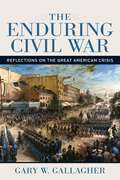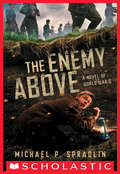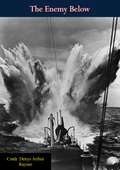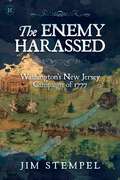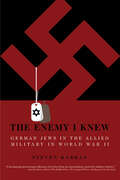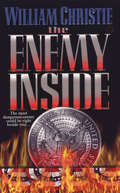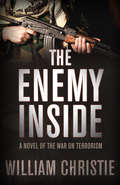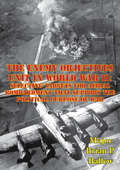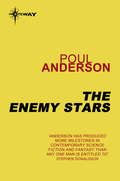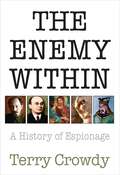- Table View
- List View
The End of the Age of Innocence: Edith Wharton and the End of the First World War
by Alan PriceEvaluation of her work.
The End of the Age of Innocence: Edith Wharton and the First World War
by Alan PriceThis book provides an overview of Wharton's life during World War II and how the war affected her writing and world-view. This book includes extensive new information on Wharton - based upon her unpublished letters, archival materials, and the extensive research by the author.
The End of the Battle (Sword of Honour Trilogy #3)
by Evelyn WaughGuy Crouchback is given one final assignment in Yugoslavia, at the end of WWII. Concluding volume of the Sword of Honour trilogy.
The End of the Beginning: 1943 (Winston S. Churchill War Speeches)
by Winston S. ChurchillThis collection of WWII speeches by the Nobel Prize-winning Prime Minister reflect his determination in the face of a fearsome enemy. 1942 was an important turning point in World War II. Britain and its allies had faced considerable challenges thus far. Beset by bombings and devastated by personal loss and the restrictions of war, the British public was losing patience with the war effort—and their prime minister. This collection of Winston Churchill&’s wartime speeches from 1942 provides an enlightening commentary on this volatile time in history from the point of view of one of its most prominent leaders. Churchill faced an uphill battle in his military efforts as well as in gathering political and public support for the struggle to come. But the tides had turned when the United States joined the war at the end of 1941. Churchill has been quoted as saying he felt certain of the Allied victory with the US on his side—and his speeches reflect this renewed sense of hope and conviction.
The End of the Cold War
by David Armstrong Erik GoldsteinGiving an overview of the origins and history of the Cold War, this work considers whether the Cold War is truly over, and what the effects have been on Europe, and the former Soviet Union, as well as US foreign policy.
The End of the Future: Trauma, Memory, and Reconciliation in Peruvian Amazonia
by Bartholomew DeanIn The End of the Future, author Bartholomew Dean broadens the theoretical framework for understanding memory's role in reconciliation following a violent conflict. This book explores the complicated and confusing linkages between memory and trauma for individuals caught up in civil war and post-conflict reconciliation in the Peruvian Amazon's Huallaga Valley—an epicenter for leftist rebels and a booming shadow economy based on the extraction and circulation of cocaine. The End of the Future tells the story of violent attempts by the Túpac Amaru Revolutionary Movement (Movimiento Revolucionario Túpac Amaru, MRTA) to overthrow the state in the late 1980s and early 1990s from the perspective of the poorest residents of the lower Huallaga's Caynarachi Basin. To give context to the causes and consequences of the MRTA's presence in the lower and central Huallaga, this book relies on the written works and testimony of Sístero García Torres, an MRTA rebel commander; the government's Truth and Reconciliation Commission; MRTA propaganda; media accounts; and critical historical texts. Besides exposing Huallaga Valley human rights abuses, the book's contribution to political anthropology is consequential for its insistence that reconciliation is by no means equivalent to local, Indigenous notions of "justice" or customary forms of dispute resolution. Without deliberately addressing the diverse socio-cultural contours defining overlapping epistemologies of justice, freedom, and communal well-being, enduring reconciliation will likely remain elusive.
The End of the Old Order: Napoleon and Europe, 1801-1805
by Frederick KaganPerhaps no person in history has dominated his or her own era as much as Napoleon. Despite his small physical stature, the shadow of Napoleon is cast like a colossus, compelling all who would look at that epoch to chart their course by reference to him. For this reason, most historical accounts of the Napoleonic era-and there are many-tell the same Napoleon-dominated story over and over again, or focus narrowly on special aspects of it. Frederick Kagan, distinguished historian and military policy expert, has tapped hitherto unused archival materials from Austria, Prussia, France, and Russia, to present the history of these years from the balanced perspective of all of the major players of Europe. InThe End of the Old Orderreaders encounter the rulers, ministers, citizens, and subjects of Europe in all of their political and military activity-from the desk of the prime minister to the pen of the ambassador, from the map of the general to the rifle of the soldier. With clear and lively prose, Kagan guides the reader deftly through the intriguing and complex web of international politics and war. The End of the Old Orderis the first volume in a new and comprehensive four-volume study of Napoleon and Europe. Each volume in the series will surprise readers with a dramatically different tapestry of early nineteenth-century personalities and events and will revise fundamentally our ages-old understanding of the wars that created modern Europe.
The End of the Ottoman Empire and the Forging of the Modern Middle East: A Short History with Documents (Passages: Key Moments in History)
by Martin Bunton Andrew Wender"In one hundred and twenty pages this book provides a compelling account of the shaping of the modern Middle East, and the critical part played in that process by the Ottoman Empire, even as it fell apart. It offers a mine of background information for anyone wishing to understand the current scene. Thirty-four well-chosen documents, mainly culled from the archives, buttress and illuminate the story." —Jonathan Schneer, Georgia Institute of Technology, author of The Balfour Declaration: The Origins of Arab-Israeli Conflict
The End: A Postapocalyptic Novel (New World Series #1)
by G. Michael HopfWhat would you do to survive?<P><P> Young Gordon Van Zandt valued duty and loyalty to country above all, so after 9/11, he dropped out of college and joined the Marine Corps. This idealism vanished one fateful day in a war-torn city in Iraq. Ten years later, he is still struggling with the ghosts of his past when a new reality is thrust upon him and his family: North America, Europe and the Far East have all suffered a devastating Super-EMP attack, which causes catastrophic damage to the nation's power grid and essential infrastructures. Everything from cell phones to cars to computers cease to function, putting society at a standstill.<P> With civilization in chaos, Gordon must fight for the limited and fast dwindling resources. He knows survival requires action and cooperation with his neighbors, but as the days wear on, so does all sense of civility within his community--and so he must make some of the most difficult decisions of his life in order to ensure his family's safety. <P> For readers of Going Home by A. American, Lights Out by David Crawford, Lucifer's Hammer by Jerry Pournelle and One Second After by William Forstchen.
The End: An Owen Taylor Story (BookShots)
by James Patterson Brendan DuboisIf the mission fails, it's World War III. Any questions? Owen Taylor is about to be betrayed on his final covert mission. It will take everything he has to make it home alive, and to save the woman he loves. BookShotsLIGHTNING-FAST STORIES BY JAMES PATTERSON Novels you can devour in a few hours Impossible to stop reading All original content from James Patterson
The Endgame
by Michael R. Gordon Bernard E. TrainorEagerly anticipated in the wake of their national best seller Cobra II ("The superb, must-read military history of the invasion of Iraq"--Thomas L. Friedman), The Endgame is Michael R. Gordon and General Bernard E. Trainor's most ambitious and news-breaking book to date. A peerless work of investigative journalism and historical recreation ranging from 2003 to 2012, it gives us the first comprehensive, inside account of arguably the most widely reported yet least understood war in American history--from the occupation of Iraq to the withdrawal of American troops. Prodigiously researched, The Endgame is not only based on an abundance of highly classified, still-secret government documents but is also brilliantly informed by access to key figures in the White House, the military, the State and Defense departments, the intelligence community, and, most strikingly, by extensive interviews with both Sunni and Shiite leaders, key Kurdish politicians, tribal sheikhs, former insurgents, Sadrists, and senior Iraqi military officers, whose insights about critical turning points and previously unknown decisions made during the war have heretofore been conspicuously missing from the media's coverage of it. The Endgame is riveting as a blow-by-blow chronicle of the fighting. It is also relentlessly revealing, as it deftly pieces together the puzzle of the prosecution of American, Iraqi, and Iranian objectives, and the diplomatic intrigue and political struggle within Iraq since the American invasion.
The Ending of Tribal Wars: Configurations and Processes of Pacification (Routledge Studies in Modern History #79)
by Jürg Helbling Tobias SchwoererAll over the world and throughout millennia, states have attempted to subjugate, control and dominate non-state populations and to end their wars. This book compares such processes of pacification leading to the end of tribal warfare in seven societies from all over the world between the 19th and 21st centuries. It shows that pacification cannot be understood solely as a unilateral imposition of state control but needs to be approached as the result of specific interactions between state actors and non-state local groups. Indigenous groups usually had options in deciding between accepting and resisting state control. State actors often had to make concessions or form alliances with indigenous groups in order to pursue their goals. Incentives given to local groups sometimes played a more important role in ending warfare than repression. In this way, indigenous groups, in interaction with state actors, strongly shaped the character of the process of pacification. This volume’s comparison finds that pacification is more successful and more durable where state actors mainly focus on selective incentives for local groups to renounce warfare, offer protection, and only as a last resort use moderate repression, combined with the quick establishment of effective institutions for peaceful conflict settlement.
The Ends of the Earth: Fourteen Stories
by Lucius ShepardLucius Shepard's short fiction ranges far and wide over the field of SF and fantasy, and is crammed with show-stopper ideas and an intense originality. The Ends of the Earth is a testimonial to a genius of the genre, and a major American writer. Winner of the 1992 World Fantasy Award for Best Collection.Contents:The Ends of the Earth (1989)Delta Sly Honey (1987)Bound for Glory (1989)The Exercise of Faith (1987)Nomans Land (1988)Life of Buddha (1988)Shades (1987)Aymara (1986)A Wooden Tiger (1988)The Black Clay Boy (1987)Fire Zone Emerald (1985)On the Border (1987)The Scalehunter's Beautiful Daughter (1988)Surrender (1989)
The Enduring Civil War: Reflections on the Great American Crisis
by Gary W. GallagherIn the seventy-three succinct essays gathered in The Enduring Civil War, celebrated historian Gary W. Gallagher highlights the complexity and richness of the war, from its origins to its memory, as topics for study, contemplation, and dispute. He places contemporary understanding of the Civil War, both academic and general, in conversation with testimony from those in the Union and the Confederacy who experienced and described it, investigating how mid-nineteenth-century perceptions align with, or deviate from, current ideas regarding the origins, conduct, and aftermath of the war. The tension between history and memory forms a theme throughout the essays, underscoring how later perceptions about the war often took precedence over historical reality in the minds of many Americans. The array of topics Gallagher addresses is striking. He examines notable books and authors, both Union and Confederate, military and civilian, famous and lesser known. He discusses historians who, though their names have receded with time, produced works that remain pertinent in terms of analysis or information. He comments on conventional interpretations of events and personalities, challenging, among other things, commonly held notions about Gettysburg and Vicksburg as decisive turning points, Ulysses S. Grant as a general who profligately wasted Union manpower, the Gettysburg Address as a watershed that turned the war from a fight for Union into one for Union and emancipation, and Robert E. Lee as an old-fashioned general ill-suited to waging a modern mid-nineteenth-century war. Gallagher interrogates recent scholarly trends on the evolving nature of Civil War studies, addressing crucial questions about chronology, history, memory, and the new revisionist literature. The format of this provocative and timely collection lends itself to sampling, and readers might start in any of the subject groupings and go where their interests take them.
The Enemy Above: A Novel of World War II
by Michael P. SpradlinNazi gun fire can only mean one thing... The Germans are closing in. And twelve-year-old Anton knows his family can't outrun them. A web of underground caves seems like the perfect place to hide. But danger lurks above the surface. Ruthless Major Karl Von Duesen of the Gestapo has made it his mission to round up every Jew in the Ukrainian countryside. Anton knows if his community is discovered, they will be sent off to work camps...or worse. When a surprise invasion catches them off guard, Anton makes a radical decision. He won't run any longer. And he won't hide. He will stop being the hunted...and start doing some hunting of his own. Michael P. Spradlin's newest thriller is the ultimate game of cat and mouse set during one of the darkest moments in history.
The Enemy Below
by Cmdr. Denys Arthur RaynerDUEL AT SEAFrom the moment the radar indicated a German sub, the captain of the destroyer Hecate knew he would achieve his life’s ambition—a duel to the death in deserted waters between his ship and an enemy submarine.Below the choppy sea sped the U-121 commanded by Kapitän von Stolberg, an efficient, brutal sailor who also welcomed a fight to the finish—but for a different reason. His submarine was entrusted with a mission that could prove catastrophic to the Allied war effort. Nothing—least of all a British destroyer—must stand in his way.Plotting his strategy like a deadly game of chess, the destroyer captain doggedly tailed the elusive sub. Depth charge answered torpedo, cannon matched gun and finally man faced man in a climactic battle for supremacy at sea.THE ENEMY BELOW was also made into the Academy Award winning 1957 movie, starring Robert Mitchum and Curt Jürgens, and produced and directed by Dick Powell.THE ENEMY BELOW...”Simply terrific!”—Christian HeraldTHE ENEMY BELOW...”Commander Rayner has spun a grand yarn. The battle he has described is a thriller, a cross between a game of chess and a hunt to the death. He tells it well, with mounting suspense, much clever manipulation of the possibilities of naval action and with a slam-bang climax which ought to be terrific in the forthcoming movie.”—The New York TimesTHE ENEMY BELOW...”A thumping good narrative of primordial war at sea told from an unusual point of view...”—The New York Times Book Review
The Enemy Harassed: Washington's New Jersey Campaign of 1777
by Jim StempelAs few books regarding American history have achieved, Jim Stempel&’s The Enemy Harassed brings a previously neglected period of the American Revolution to life.In late December 1776, the American War of Independence appeared to be on its last legs. General George Washington&’s continental forces had been reduced to a shadow of their former strength, the British Army had chased them across the Delaware River into Pennsylvania, and enlistments for many of the rank and file would be up by month&’s end. Desperate times call for desperate measures, however, and George Washington responded to this crisis with astonishing audacity. On Christmas night 1776, he recrossed the Delaware as a nor&’easter churned up the coast, burying his small detachment under howling sheets of snow and ice. Undaunted, they attacked a Hessian brigade at Trenton, New Jersey, taking the German auxiliaries by complete surprise. Then, only three days later, Washington struck again, crossing the Delaware, slipping away from the British at Trenton, and attacking the Redcoats at Princeton—to their utter astonishment. The British, now back on their heels, retreated toward New Brunswick as Washington&’s reinvigorated force followed them north into Jersey. Over the next eight months, Washington&’s continentals and the state militias of New Jersey would go head-to-head with the British in a multitude of small-scale actions and large-scale battles, eventually forcing the British to flea New Jersey by sea. In this captivating narrative of the American War of Independence, author Jim Stempel brings to life one of the most violent, courageous, yet virtually forgotten periods of the Revolutionary War. Sure to enthrall professional historians and book lovers of all stripes, The Enemy Harassed is scholarly history presented in an accessible style anyone can enjoy.
The Enemy I Knew: German Jews in the Allied Military in World War II
by Steven KarrasJewish refugees who fled the Nazis—then returned to fight them as Allied soldiers—share their experiences: “Heroic, poignant [and] compelling.” —The Daily NewsEven Holocaust survivor Elie Wiesel struggled with the question: Why didn’t the Jews fight back? But he finally concluded that the real question was how so many of them did. As he put it, “Tormented, beaten, starved, where did they find the strength—spiritual and physical—to resist?” In fact, over 10,000 German Jews fought in the Allied armies of World War II. This book honors those European-born combat veterans—refugees from the Nazi regime in Germany and Austria who faced their persecutors by joining the Allied forces in a fight against the country of their birth. These twenty-seven interviews take us into the unique and harrowing experiences of brave men—and one brave woman—whose service restored a sense of dignity and allowed them to rise above their former victimization. All burned with anger at the Germans who’d subjected them, often as young children, to cruelty in everyday life in their hometowns, and to ridicule in the national media. As soldiers who knew the language and psychology of the enemy better than any of their comrades, they struck back with newfound pride against the rampant injustice that had annihilated their families, destroyed their prospects, and subjected many of them to the worst forms of physical abuse, both random and terrifying. In The Enemy I Knew they tell their stories—and the world is richer for their heroic acts, and for their testimony.“It is rare to come across a book about a forgotten story from World War II, but Steve Karras has found one of the most compelling, little-known accounts from the war and he tells it brilliantly. Harrowing, breathtaking in parts, and completely absorbing.” —Andrew Carroll, New York Times–bestselling editor of War Letters“Few stories can rival the ones told in The Enemy I Knew.” —Library Journal (starred review)
The Enemy Inside
by William ChristieIn his electrifying thriller Threat Level, William Christie brought readers into a lethal world of international shadow ops and covert warfare. Now he continues the explosive intrigue with a chilling novel of unknown soldiers, unwavering loyalty--and ultimate betrayal from within. . . The enemy has found a new path to America's doorstep, and is approaching fast. In South America, covert operatives Ed Storey and Lee Troy discover that Al Qaeda and the criminal underworld have combined their resources, with money moving from the jungles to the deserts of the Middle East. And now terrorists are moving from the Middle East right to the U. S. /Mexican border. There is a nightmarish plan in the works--and time is running out to stop it. But the madmen of Al Qaeda are already moving towards their goal--a devastating attack that will disrupt the presidential election and drain the Americans of their will to fight. And as Storey and Troy work their way closer to the terrorists, the odds against them skyrocket. For the terrorists have a secret ally who has been guiding them in their quest for bloodshed--an ally who works on the inside. . . "All too credible in its details. A genuine page-turner. " --Publishers Weekly, on William Christie's The Warriors of God William Christie is a former Marine Corps infantry officer. He is the author of the acclaimed novels, Mercy Mission and The Warriors of God. He lives in North Carolina.
The Enemy Inside
by William ChristieIn his electrifying thriller Threat Level, William Christie brought readers into a lethal world of international shadow ops and covert warfare. Now he continues the explosive intrigue with a chilling novel of unknown soldiers, unwavering loyalty--and ultimate betrayal from within. . . The enemy has found a new path to America's doorstep, and is approaching fast. In South America, covert operatives Ed Storey and Lee Troy discover that Al Qaeda and the criminal underworld have combined their resources, with money moving from the jungles to the deserts of the Middle East. And now terrorists are moving from the Middle East right to the U.S./Mexican border. There is a nightmarish plan in the works--and time is running out to stop it. But the madmen of Al Qaeda are already moving towards their goal--a devastating attack that will disrupt the presidential election and drain the Americans of their will to fight. And as Storey and Troy work their way closer to the terrorists, the odds against them skyrocket. For the terrorists have a secret ally who has been guiding them in their quest for bloodshed--an ally who works on the inside. . . "All too credible in its details. A genuine page-turner." --Publishers Weekly, on William Christie's The Warriors of God William Christie is a former Marine Corps infantry officer. He is the author of the acclaimed novels, Mercy Mission and The Warriors of God. He lives in North Carolina.
The Enemy Inside
by William ChristieIn this heart-pounding sequel to Threat Level, Special Forces operators Ed Storey and Lee Troy uncover an Al Qaeda network funneling smuggled cash from South America to the Middle East. In Los Angeles, FBI Special Agent Beth Royale investigates another network turning criminal profit into terrorist capital. As the two investigations link up, it becomes clear that their mission is not identifying and halting Al Qaeda's financing; it's tracking and stopping Al Qaeda as they move through South America toward the US-Mexico border as the US presidential election draws near. And this time, the odds are stacked in the terrorists' favor: Help comes from someone inside the US government and from Los Zetas, the lethal gang of Mexican drug cartel enforcers.
The Enemy Objectives Unit In World War II: Selecting Targets for Aerial Bombardment That Support The Political Purpose Of War
by Major Brian P. BallewIn June of 1942, Eighth Air Force deployed to the UK and began preparation for a bombing campaign. However, during the initial planning efforts it became apparent the staff lacked the expertise needed to analyze and recommend bombing targets. Colonel Richard Hughes, the Chief Planner for American Air Forces in Europe, recognized this deficiency and requested a team to assist with target selection. The Enemy Objectives Unit (EOU), a team of civilian economists, began arriving in London in September 1942 to support the Eighth Air Force.While formally assigned to the US Embassy in London, for practical purposes the team worked for Colonel Hughes. Using their economic expertise, EOU members studied the German industrial complex to identify vulnerabilities and then recommend to planners and senior leaders those industries the US Strategic Air Forces in Europe should target. Taking an effects-based approach, the team sought to maximize the efficiency and effectiveness of US airpower to produce the greatest effects on Germany's war economy.The EOU's target selection methodology required intelligence data on enemy targets, an awareness of United States Army Air Forces bombing capabilities, and most importantly an understanding of military and political aims. To ensure selected targets aligned with military and political aims, the EOU regularly collaborated with air planning staffs and senior leaders. Three case studies highlight the interaction and collaboration that occurred between the EOU and Army Air Forces planners and leaders: prioritizing targets for Operation POINTBLANK, development of an Oil Plan following "Big Week" in Feb. 1944, and the recommendation to strike bridges versus marshaling yards prior to Operation OVERLORD. Each of these case studies demonstrates that the integration and cooperation between the EOU and air force leaders and planning staffs ensured that targets selected for aerial bombardment supported political and military objectives.
The Enemy Stars
by Poul AndersonThey built a ship called the Southern Cross and launched her to Alpha Crucis. Centuries passed, civilisations rose and fell, the very races of mankind changed, and still the ship fell on her headlong journey toward the distant star.After ten generations the Southern Cross was the farthest thing from Earth of any human work - but she was still not halfway to her goal.Here is an absolutely absorbingly exciting tale of the far future from one of the giants in the field of Science Fiction writing.
The Enemy Within: A History of Spies, Spymasters and Espionage
by Terry CrowdyTo gain the upper hand in conflict the ability to know what your enemy is planning is vital. Massive amounts of money have been spent and many lives have been lost in pursuit of this objective. From biblical times to the present day, leaders have employed espionage on and off the battlefield in the quest for victory. Tactics might differ, from dirty tricks and theft to interrogation and torture, but the aim is the same - to outmanoeuvre your enemy and emerge triumphant. Separating myth from reality, the Enemy Within, traces the history of espionage from its development in ancient times through to the end of the Cold War and beyond, shedding light on the clandestine activities that have so often tipped the balance in times of war. This detailed account delves into the murky depths of the realm of the spymasters and their spies, revealing many amazing, and often bizarre stories, along the way. From the Monkey hanged as a spy during the Napoleonic wars to the British Double Cross Committee in World War II and from Ivan the Terrible's forming of the first Russian secret police in the 16th century to the infiltration of the IRA in the 20th century, this journey through the history of espionage shows us that be they thrill seekers or madmen, fanatics or tricksters no two spies are alike and their fascinating stories are fraught with danger and intrigue.CHAPTER HEADS In ancient times. Through dark ages. Spy, Britannia! Espionage in the Age of Reason. Vive la revolution! Napoleon's 'secret part'. Uncivil war. The godfather of secret service. Spy fever. Double-cross agents and radio games. Axis spies against America. Spies of the Soviet era. With no end in sight.From the Hardcover edition.
The Enemy at His Back
by Elizabeth Churchill BrownThis work discusses the communist schedule for taking over America and its potential loss of liberty. The author’s goal is to succeed in awakening the American people to the immediate mortal danger and have better knowledge on how to protect ourselves from communism.“Elizabeth Churchill Brown’s book is one of the clearest and most factual expositions of Communist influence on American foreign policies and actions that I have read. This book should be read in all American homes and schools and should be required reading by every American in Government Service.”—General Albert C. Wedemeyer
